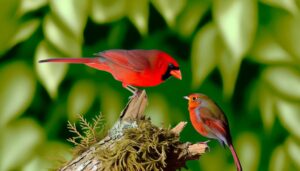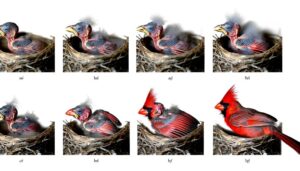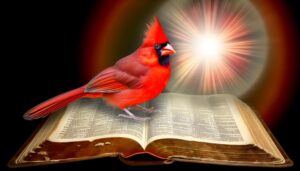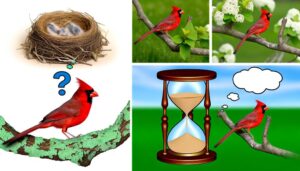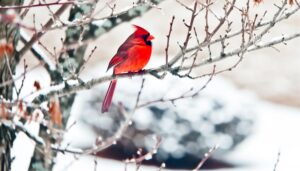How to Identify All Red Birds: Cardinals or Not?
No, not all red birds are cardinals. While cardinals are famous for their bright red plumage, other bird species also display red hues.
Biological processes and environmental factors play a role in these variations. It's not just color you should look at.
A cardinal's distinctive features include a crest on top of their head and a unique song pattern. Misidentification can occur when similar colors appear among different species.
Further exploration into the fascinating domains of avian behavior, habitat, and physical traits will reveal the diverse universe of not only the cardinal but also other vibrant red-feathered species.
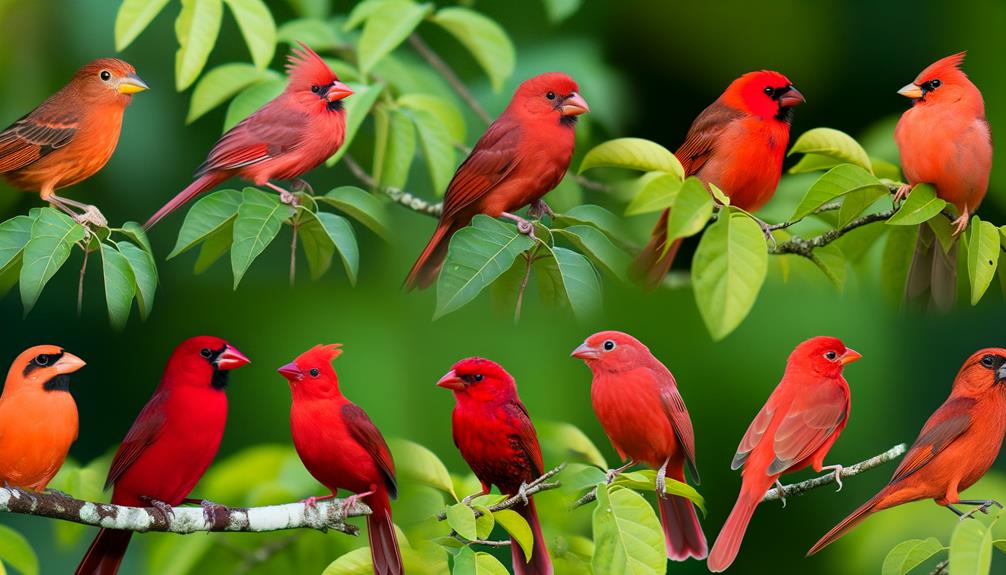
Key Takeaways
- Not all red birds are cardinals; other red-feathered species exist.
- Cardinals are distinguished by their bright red plumage, crest, and black 'mask'.
- Bird color patterns can be influenced by diet, age, and season, leading to misidentification.
- Cardinals have a unique song and behavior, aiding in their identification.
- Understanding bird color patterns and unique features can help in correctly identifying cardinals.
The Cardinal Bird: A Brief Overview

Diving into the world of ornithology, you'll quickly discover that the cardinal bird, with its distinctive red plumage and crest, is far more complex and intriguing than meets the eye.
Not all red birds you'll encounter are cardinals. Indeed, there's a diverse array of species flaunting this fiery hue. Yet, the cardinal bird, specifically the Northern Cardinal, stands out.
Possessing keen adaptability, they've spread across North America, flourishing in diverse habitats. They're non-migratory, choosing instead to brave winter's chill. This resilience symbolizes the freedom and tenacity you may seek.
Their song, a melody of whistles, is unique and memorable. Beyond their vibrant appearance, understanding their behavior and characteristics will reveal the true complexity of these magnificent birds.
Identifying the Cardinal: Key Features
When identifying a cardinal, you'll first focus on its distinctive physical traits, which are unique and easily recognizable.
You'll also observe its behavior patterns, as they're quite distinctive and differ from other birds.
Cardinal's Distinctive Physical Traits
You'll quickly recognize a cardinal by its distinctive physical traits, which include a bright red plumage, a crest on top of its head, and a black 'mask' that spans from its eyes to its throat. This mask is more pronounced in male cardinals, contributing to their striking appearance.
The bird's size is also noticeable; they measure around 8.3–9.1 inches in length, with a wingspan of 9.8–12.2 inches. Importantly, there's sexual dimorphism; while males are mainly red, females display a duller brown color with reddish hues on the wings, tail, and crest.
Their beaks are robust and conical, perfectly designed for seed-cracking, and are a vivid orange-red color. These physical traits are key in differentiating the cardinal from other red birds.
Cardinal's Unique Behavior Patterns
Beyond their distinctive physical traits, cardinals also exhibit unique behavior patterns that can aid in their identification. For instance, cardinals are diurnal, meaning they're active during the day. You'll often spot them at dawn or dusk, feeding in pairs or small groups. They're also known for their melodic songs.
Males use these complex songs to defend their territory, while females sing to communicate with their mates. Moreover, cardinals are monogamous, typically pairing for life. During courtship, the male feeds seeds to the female beak-to-beak, a behavior unique to this species.
Cardinal's Habitat and Distribution
In the heart of North America, amidst densely packed forests to suburban backyards, you can find the cardinal's diverse habitats stretching from southern Canada down through the United States and into Mexico. They're quite adaptable birds, thriving in a variety of environments. Cardinals aren't picky about their homes. You'll find them in woodlands, swamps, and gardens.
To help you visualize, here's a table showing cardinal distribution:
| Region | Cardinal Presence | Habitat |
|---|---|---|
| Canada | Yes | Forests |
| United States | Yes | Suburban Backyards |
| Mexico | Yes | Woodlands |
This versatile bird's ability to inhabit different areas is a demonstration of its adaptability. So, no matter where you're located in North America, there's a good chance you'll spot a cardinal.
Understanding Bird Color Variations
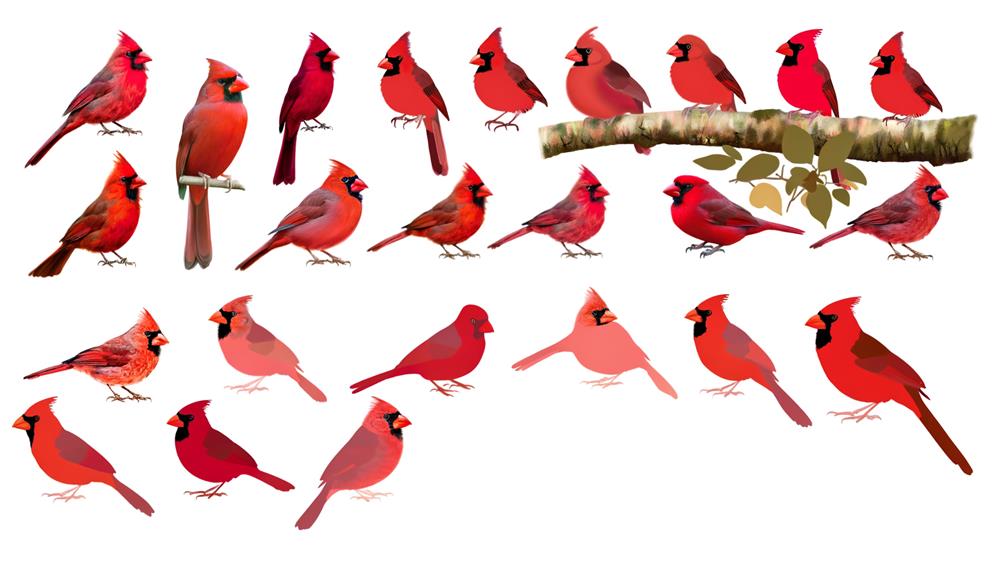
You'll now explore the fascinating topic of bird color variations. Understanding these color patterns helps in distinguishing a wide array of red birds, not all of which are cardinals.
Misidentification can be a common issue, but with careful observation and knowledge, you can accurately identify different species.
Decoding Bird Color Patterns
To decode bird color patterns, it's essential to understand the variations in bird coloration, which are often the result of complex biological processes and environmental interactions.
These patterns aren't just random; they're shaped by several factors. For instance, pigments in birds' feathers are often influenced by diet, while structural colors are determined by the physical arrangement of the feathers. Additionally, the combination of pigments and structures can create a wide array of hues.
Environmental factors, such as UV radiation, can also impact the color intensity. Remember, color patterns often serve specific purposes, such as attracting mates or camouflage.
Diversity Among Red Birds
Diving into the world of red birds, you'll quickly discover a surprising array of species and color variations, far beyond the well-known cardinal. The red feathers can range from deep crimson to bright scarlet, with some species even exhibiting multiple hues on a single feather.
Here's a simple table to showcase the diversity:
| Species | Feather Color | Region |
|---|---|---|
| Scarlet Tanager | Vibrant Red | Eastern America |
| Northern Cardinal | Deep Crimson | North America |
| Summer Tanager | Scarlet | Southern US |
| Vermilion Flycatcher | Bright Red | South America |
| House Finch | Rosy Red | North America |
Each species has its unique charm, with variations in red hues and distribution areas. You're free to explore the beauty and diversity of these red birds, appreciating the vast natural world.
Cardinal Misidentification Issues
Despite their striking red color, cardinals often get mixed up with other red-feathered species due to similar color variations, leading to common identification issues among bird enthusiasts. You might think you've spotted a cardinal, only to realize it's a summer tanager, scarlet tanager, or a vermilion flycatcher. These species all display red plumage, but they're not cardinals.
Recognize that the color intensity in birds can vary greatly based on factors like diet, age, and season. Take note of other distinctive features like size, beak shape, and song. Cardinals, for example, have a unique crest and sing a variety of tunes.
Other Red Birds: The Scarlet Tanager
While the Cardinal may be the most well-known red bird, there's another vibrant species you may not be familiar with: the Scarlet Tanager. This striking bird is native to the eastern parts of North America. You'll recognize it by its bold red body and black wings, a contrast that makes it stand out in the green foliage.
It's smaller than the Cardinal, often measuring between 6.5 and 7.5 inches in length. Its diet consists mainly of insects and fruits. Males only don these vivid colors during the breeding season, while females and young ones are a modest yellow-green.
If you're seeking freedom and diversity in your bird-watching endeavors, don't limit your vision to Cardinals. The Scarlet Tanager is a sight to behold.
The Vibrant Vermilion Flycatcher
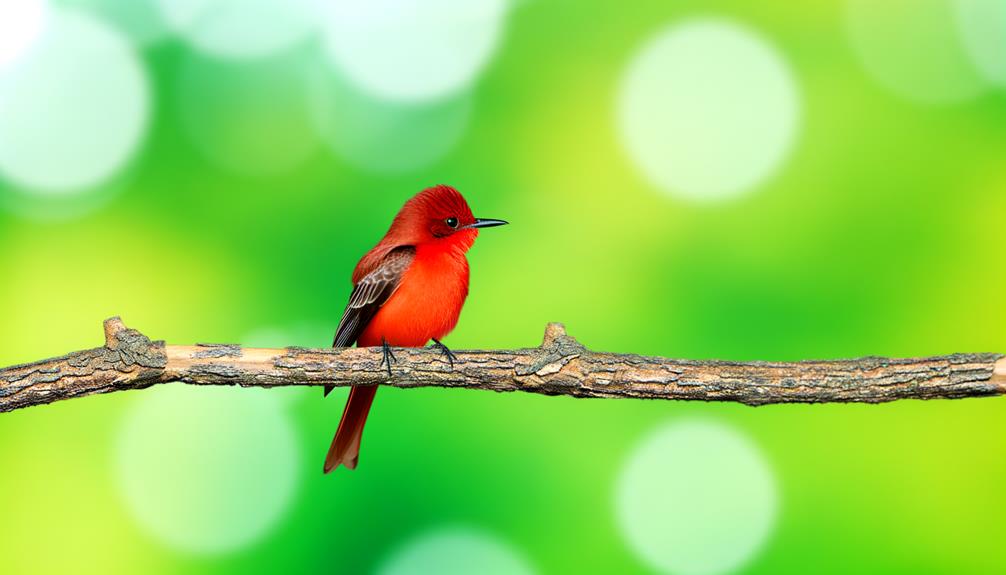
Moving to a different species, you might be excited to discover the Vermilion Flycatcher, an equally enchanting red bird that boasts a rich, fiery coloration.
This small passerine bird is native to the southwestern United States, Mexico, and parts of South America. The male is the true showstopper, with a strikingly vivid red crown and underparts, contrasted against a dark, almost black back. It's a sight that truly captivates birdwatchers and casual observers alike.
You'll often find them perched on low branches in open areas, actively hunting for insects. Unlike many other birds, the Vermilion Flycatcher won't shy away from expressing its fiery spirit, choosing freedom over camouflage. Its bold coloration is a sign of the bird's desire to stand out, to be seen, and to be admired.
Lesser-Known Red Birds: The Summer Tanager
Venturing into less-explored territory, you'll stumble upon the Summer Tanager, a fascinating red bird that's often overlooked in favor of more famous species. This bird is a sight to behold, offering a unique blend of beauty and mystery.
- *Scientific Name:* Piranga rubra, a name that reflects its vivid color.
- *Habitat:* Mainly found in the southern regions of the United States during the summer months.
- *Appearance:* Adult males are entirely red, while females and young males sport a more modest olive-yellow.
- *Diet:* An insectivore with a particular fondness for bees and wasps.
- *Migration:* Winters in tropical Central and South America, embracing the freedom of the skies.
The Summer Tanager is an embodiment of freedom, a less-explored beauty that captivates those who seek it out.
The Northern Flicker: A Red Bird Species
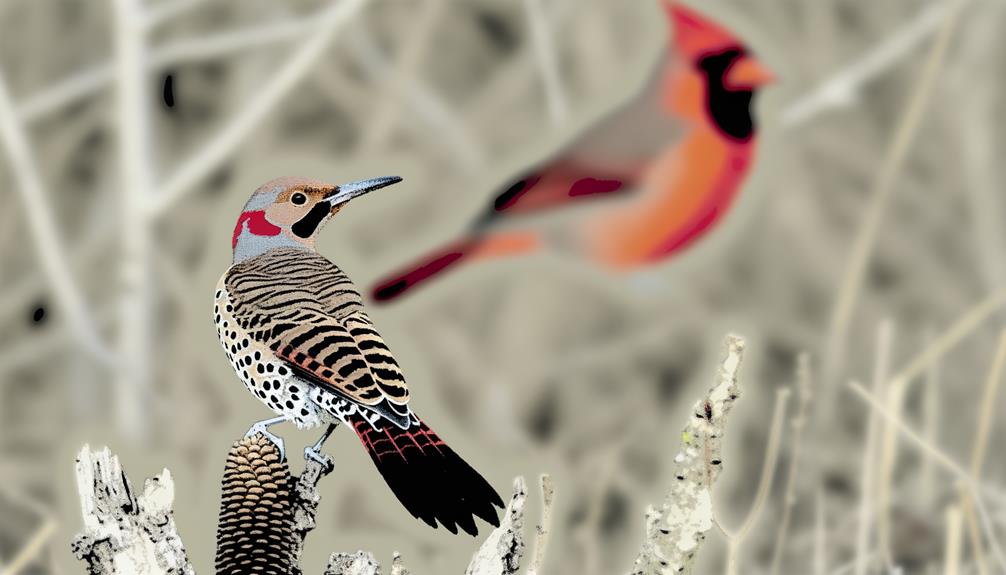
Switching our focus to another intriguing red bird species, you'll encounter the Northern Flicker, a creature known for its distinct markings and behavior. This bird, belonging to the woodpecker family, exhibits a bright red patch on the nape of its neck, setting it apart from its kin.
Unlike most woodpeckers, the Northern Flicker prefers to forage on the ground, hunting for ants and beetles. Its unique flight pattern, featuring a series of rapid wingbeats followed by a short glide, is another characteristic that sets it apart.
Concerning habitat, you'll find this bird across North America, making its home in forests, woodlands, and suburban areas alike. So, while not a cardinal, the Northern Flicker is a remarkable red bird worthy of exploration.
The Eye-Catching House Finch
While cardinals and Northern Flickers often steal the spotlight, you shouldn't overlook the House Finch, a vibrant red bird that adds a splash of color to many North American backyards. This species has a unique charm and scientific significance.
Look out for the House Finch and you'll notice:
- Their distinct red coloration, often more orange or yellow depending on diet.
- A robust, conical beak adapted for seed consumption.
- Their song, a lively, warbling tune that's a joy for birdwatchers.
- The difference in plumage between males and females, with males being brighter.
- Their adaptable nature, thriving in both rural and urban environments.
Not Quite Cardinals: The Red-Winged Blackbird
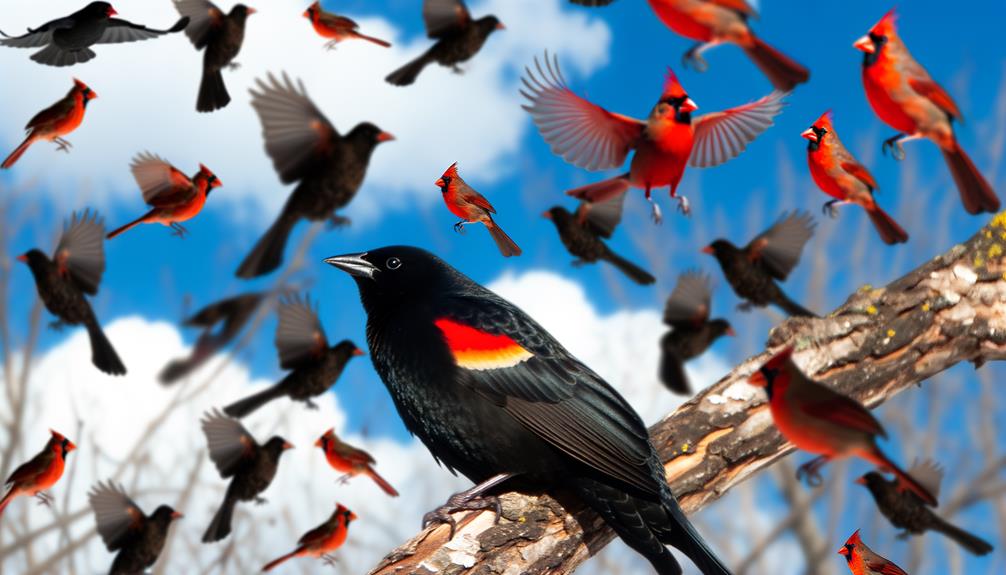
If you cast your eyes towards the marshlands, you're likely to spot the Red-Winged Blackbird, a distinct species that, despite its primarily black plumage, boasts vibrant red patches on its wings that are hardly less striking than a cardinal's scarlet coat.
This bird, scientifically known as Agelaius phoeniceus, is a prime example of sexual dimorphism, with males flaunting those iconic red and yellow wing badges. Females, however, don a more subdued brown feathering.
They're not cardinals, but their striking appearance and distinct call, a mix of a conk-la-ree sound and a variety of chatters, still draw attention. So, next time you're in the wild, don't restrict your search to cardinals; the freedom to explore could lead you to the vibrant Red-Winged Blackbird.
Endangered Red Birds: The Red Siskin
Beyond the vibrant Red-Winged Blackbird, there's another, more elusive red bird you should know about: the Red Siskin. This small finch from South America is critically endangered, and hence, not commonly seen.
The Red Siskin's population has been declining due to illegal trapping for the pet trade.
They're small birds, with males boasting a fiery red plumage, contrasting sharply with black wings and tail.
Females and juveniles, on the other hand, are more subdued with brownish-red feathers.
They're granivorous, feeding mainly on seeds, but they'll also eat small insects.
Their melodious songs have made them a target for hybridization with canaries.
Red Bird Identification Tips and Tricks
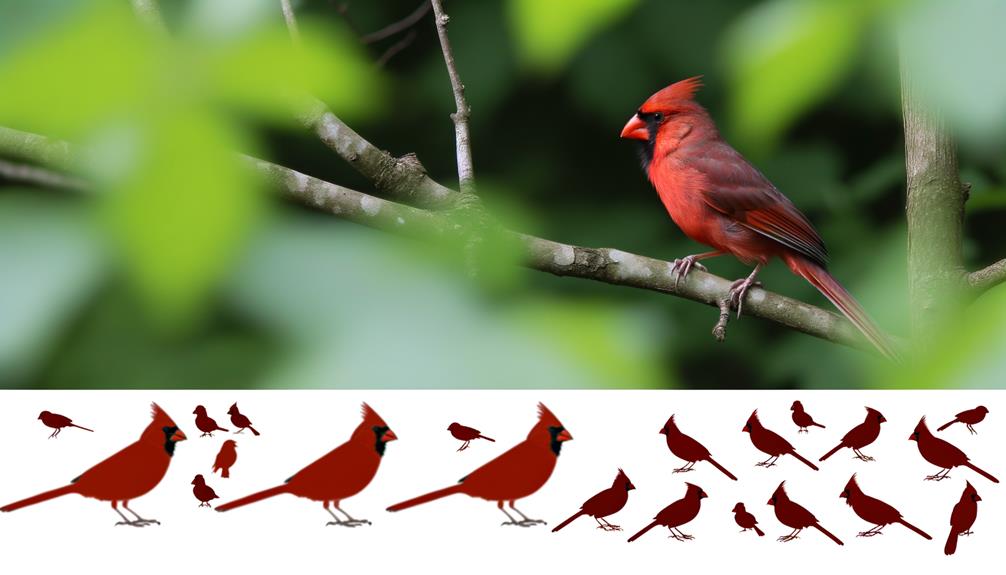
So, how can you accurately identify red birds? No, they're not all cardinals! Bird identification involves keen observation and understanding of bird features. Let's focus on some simple tips and tricks to enhance your identification skills.
| Feature | Tip |
|---|---|
| Size & Shape | Observe the bird's silhouette, beak, tail, and wings. |
| Color Pattern | Note the primary color and additional markings or patterns. |
| Behavior | Watch how the bird moves, feeds, and interacts with its environment. |
| Habitat | Consider the bird's preferred habitat: forest, wetland, desert, etc. |
| Sound | Listen for distinctive calls or songs. |
Conclusion
So, not all red birds are Cardinals. Consider the vibrant Vermilion Flycatcher, a striking little creature that could easily be mistaken for a cardinal.
Imagine the thrill of spotting one in your backyard, only to discover its true identity. It's a tribute to the wondrous diversity in nature, reminding us that there's always more to learn, explore, and appreciate in the avian world.
Keep your binoculars at the ready and your curiosity piqued.

